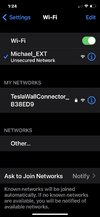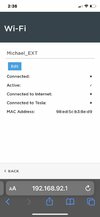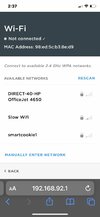I’m having trouble getting my wall charger to connect with WiFi in my garage. Interestingly, my car sees and connects to WiFi while also in the garage. I was on the phone with Wall Connector Support. The woman in support tried to be helpful but says she’s never seen this problem and can’t help. I’m not very computer savvy and what they’ve sent below is gibberish to me. I’ve attached screens from my phone, I’m connected to the wall charger, it sees my WiFi connection but doesn’t see it on the attach screen. I’m in the East Bay. Anyone I can find to help solve this issue. Thanks.
It sounds like the issue is with your router not broadcasting a proper 2.4ghz Wi-Fi signal. This is a common issue with routers and some wireless clients. Extenders tend to not play nice with wireless devices all the time.
As there are so many different router models out there we can't provide specific instruction of what to change on your router or if it doesn't work with your client. We recommend using a mesh router and or a router that lets you break apart the 2.4 ghz and 5 ghz bands to have their own names. Also to only use WPA personal security. Hope this helps.

 www.tesla.com
www.tesla.com
It sounds like the issue is with your router not broadcasting a proper 2.4ghz Wi-Fi signal. This is a common issue with routers and some wireless clients. Extenders tend to not play nice with wireless devices all the time.
As there are so many different router models out there we can't provide specific instruction of what to change on your router or if it doesn't work with your client. We recommend using a mesh router and or a router that lets you break apart the 2.4 ghz and 5 ghz bands to have their own names. Also to only use WPA personal security. Hope this helps.

Troubleshooting a Wall Connector | Tesla Support
Wall Connector is the most convenient charging solution for houses, apartments, hospitality properties and workplaces. Find out how to troubleshoot and commission a Wall Connector.





